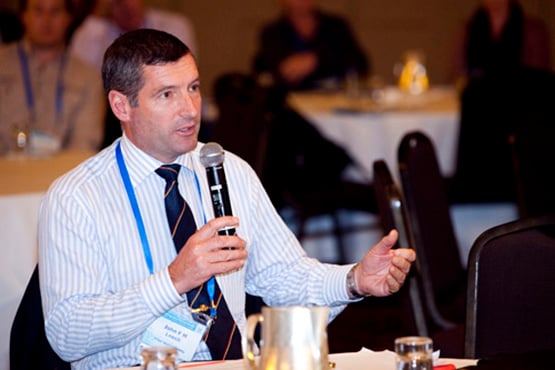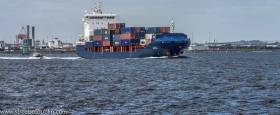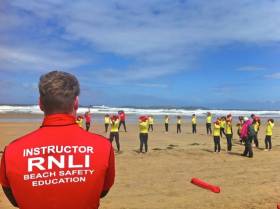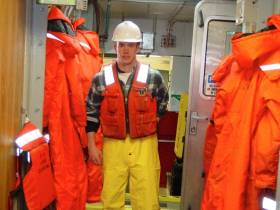Displaying items by tag: water safety
Cork Trawler Owner & Skipper Fined Over Safety Breaches
#Fishing - Out-of-date safety equipment has seen a Cork trawler skipper and owner landed with €4,000 in fines, as RTÉ News reports.
Pat O'Mahony of Kinsale and the Crosshaven-based Labardie Fisher Ltd pled guilty at district court in a case taken on behalf of the Minister for Transport, Tourism and Sport.
The former was convicted of having expired distress signals and hydrostatic life raft releases on his fishing trawler on 5 October last year.
Meanwhile, the trawler owner was fined on a charge of arriving in port with expired distress signals, and for failing to send the port superintendent a signed crew manifest as of 28 May last year.
The court heard that both skipper and owner, who lost 12 days of fishing during the investigation, co-operated fully during the process.
RTÉ News has more on the story HERE.
Warning Over Fraudulent Seafarer Certificates
#MarineNotice - Marine Notice No 19 of 2016 advises that the Department of Transport, Tourism and Sport (DTTAS) has become aware of a small number of possible fraudulent Irish seafarer certificates, and an associated fraudulent website, which purports to verify such fraudulently issued seafarer certification.
The department advises that Irish seafarer certification is only issued by the DTTAS and that all Irish certificates are to be verified at the following address:
Mercantile Marine Office
Irish Maritime Administration
Department of Transport, Tourism and Sport
Leeson Lane, Dublin 2
DO2 TR60
Ireland
Email: [email protected] Tel: +353 1 6783480
In addition, Ireland has agreements under the IMO STCW Convention and EU legislation as set out in Marine Notice No 6 of 2011 with various administrations for the recognition of certificates of competency for merchant ships.
Maritime administrations, companies and seafarers seeking to verify Irish seafarer certification should only do so with the Irish Maritime Administration directly as above.
Recall Notice For Safetmade Hydrostatic Release Units
#Recall - The UK's Maritime and Coastguard Agency (MCA) has issued a recall notice for certain models of Safetmade hydrostatic release units (HRUs).
While these HRUs have been approved as having a service life of three years, investigations have shown that some units suffered water ingress, causing corrosion leading to their malfunction under normal conditions.
The affected models are the Safetmade LR-1 and EP-1, and owners are advised to return any such units to their nearest service station or port where they can be exchanged for an equivalent HRU up till 1 September 2016.
#Lifeguards - RNLI lifeguards are hitting the surf again and bringing their popular beach safety programmes to school children and youth groups in Northern Ireland.
Hundreds of children have already been through the programmes and learned valuable and important advice to keep safe in the water and along the shore, in a fun and interactive way.
Last summer 345,027 people visited the 10 RNLI-lifeguarded beaches on the Causeway Coast and in Co Down. Of these people 27,043 entered the water while 9,975 took part in surfing or other water leisure actives such as body boarding and kite surfing.
The lifeguards responded to 182 incidents, coming to the aid of 218 people. As well as rescues carried out in the water, lifeguards also dealt with falls, first aid and lost children.
The RNLI lifeguarding season has already begun on five beaches along the Causeway Coast and this cover will be extended for the peak summer season from Saturday 25 June through to Sunday 4 September.
In the run up to this and before schools break up for the summer, the RNLI is encouraging primary schools and youth groups to sign-up for its two beach safety education programmes.
The ‘Meet the Lifeguards’ and ‘Hit the Surf’ programmes teach young people the importance of beach safety in a fun and practical way.’
‘Meet the Lifeguards’ is an interactive session where RNLI lifeguards visit a school or youth group and teach the children key safety advice that they then put to use when they visit a beach with family and friends.
Children learn what the different beach safety flags and signs mean, the safety of using inflatables, the dangers of 'tombstoning', sun safety and how to identify natural and man-made hazards in and around the water. They will also learn about body boarding and surfing safety and how to escape a rip current. Information on tides and waves is included in the session.
The ‘Hit the Surf’ programme, meanwhile, offers a unique opportunity for school children or youth groups to get practical lessons in lifesaving and beach safety at one of the 10 RNLI-lifeguarded beaches located on the North Coast and in Co Down, or inland for the first time on the shores of Lough Erne in Cp Fermanagh.
The two-and-a-half-hour session includes a lesson on staying safe at the beach and explains the role of the RNLI and its lifeguards. It is followed by a lifesaving lesson and learning surf-based skills while building the children’s confidence in the sea. They will also learn about local hazards and the beach environment.
For more information on how to book your school onto an RNLI education programme in Northern Ireland, contact RNLI lifeguard supervisor Jenny Thompson 077 8992 4563 or email [email protected]
#WaterSafety - The latest Marine Notice from the Department of Transport, Tourism and Sport addresses pleasure and recreational craft owners, masters and users with a brief summary of the legal requirements in relation to the wearing and carrying of lifejackets and buoyancy aids, the penalties arising from non-compliance, as well as advice on the selection and maintenance of personal flotation devices, or PFDs.
The reminder follows from a previous notice in August 2012, and subsequent notices on the care and use of lifejackets, as well as the 27 January edition of This Island Nation concerning good habits over the wearing of PFDs.
Full details can be found in Marine Notice No 10 of 2016, a PDF of which is available to read or download HERE.
Survivor Helps RNLI Promote Water Safety At Ireland Angling Show
#WaterSafety - Shore angler Colm Plunkett, who survived a near drowning incident last August, assisted the RNLI community safety team at the Ireland Angling 2016 show last weekend (20-21 February).
Plunkett shared his experience with hundreds of fellow anglers and watersports enthusiasts from all over Ireland – and promoted the wearing of lifejackets to help prevent the loss of life along coasts, rivers and lake shores.
As previously reported on Afloat.ie, Plunkett was swept from rocks when he was angling near Dursey Island in Cork last August. He spent 55 minutes fighting for his life before he was rescued. He was wearing a lifejacket at the time.
“My main message is that I wasn’t lucky - I was prepared but not nearly as much as I needed to be," he said. "A splash hood on my lifejacket would have saved me from an experience somewhat akin to waterboarding. A personal locator beacon (PLB) would have brought the coastguard directly to me should I have continued out to sea. It would also have initiated a distress call if I had been fishing on my own, which I often do.
"The lifejacket saved my life; the prearranged plan with my daughter saved my life; the cell phone saved my life; the emergency services saved my life. And if through telling others of my harrowing experience, on a ‘calm’ sea, I can get other fishermen to wear a life jacket then it was an experience worth having but definitely not worth repeating."
Plunkett also suggested a prearranged plan for anyone heading out on or near the water:
- Wear a well maintained lifejacket with crotch straps at all times.
- No one else should enter the water in an emergency.
- Call 112 or 999 immediately and ask for the coastguard.
John McKenna, Howth RNLI community safety officer, added: "It was fantastic to have Colm here to share his experience with other anglers. He is a very engaging speaker and he was able to offer targeted, practical suggestions to the visitors at the RNLI stand.
"We hope that it encourages people to think twice and be prepared before they go out fishing on or near the water."
The RNLI’s volunteer lifeboat crews rescued 240 shore anglers and saved 28 lives between 2010 and 2014.
The charity is aiming to reduce coastal drowning significantly by 2024 by expanding its preventative work and launching the Respect the Water campaign, which engages with water users on how to stay safe and maintain their equipment.
If any angling, sailing or boating clubs would like a member of the RNLI sea safety team to give a sea safety presentation and carry out a free lifejacket clinic, contact John McKenna at [email protected]
Clare Dominate In Water Safety National Championships
Clare lifesavers emerged as the dominant county once again despite strong challenges over two days at the University of Limerick pool for the IWS National Championships at the weekend.
Defending their overall titles in several key events, Clare won the Junior Boys, Men's and Mixed Masters contests but were beaten into second place by Wicklow in the Junior Girl's standings. Wicklow also placed second in the Senior Ladies series.
The championships attracted a record entry of 310 competitors from 12 counties around Ireland in addition to several other competition records.
This annual competition gives the best swimming pool lifesavers in Ireland an opportunity to compete in conditions that Lifesavers can encounter in real life rescue situations.
The sport of lifesaving teaches participants the skills necessary to rescue people in distress in water. Many of the competitors, having worked as Lifeguards in pools nationwide, got their chance to pitch their skills against the finest lifesavers in the country.
The events are varied and challenging with competitors swimming under obstacles, rescuing 'casualties' from the water and skilfully testing a variety of lifesaving skills in the process.
"The strong turnout this year means we can look forward to a steady stream of new lifeguards for Ireland's pools and beaches in the coming years," commented Seamus O'Neill, IWS Sports Commission chairman. "Competitors not only acquire life-saving skills but form enduring lifelong friendships around Ireland and overseas."
The championships encourage people to enrol in one of Irish Water Safety's many courses nationwide in swimming, rescue and lifesaving skills.
The event promotes the fitness and readiness for action of the lifesavers and demonstrates Lifeguard water rescues to the public through a series of competitions based around key lifesaving skills such as swimming, towing, line-throwing and use of mannikin dummies.
A total of 71 teams entered from 12 counties around the country and a team from Belfast.
Ten Irish National Records were broken; two from the Junior age category (13-16), seven in the Senior category (16+) and one world record in the masters (50 - 54)
RESULTS:
Junior Boys:
1st: Clare A
2nd: Cork A
3rd: Waterford A
Junior Girls:
1st: Wicklow A
2nd: Clare A
3rd: Waterford A
Senior Men:
1st: Clare A
2nd: Waterford A
3rd: Sligo A
Senior Ladies:
1st: Clare A
2nd: Wicklow
3rd: Wexford
Masters (male/female combined):
1st: Cork
2nd: Donegal
3rd: Wexford
New World Record (Masters aged 50-54): Norma Cahill: 200m obstacle (2m27.29secs, beating 2m32.44secs)
Report On Trawler Sinking Prompts Call For Safety Basics On Emergency Pumps, Helicopter Rescues
#MCIB - Protocols for SAR helicopter rescues and the use of emergency portable pumps should be included in safety training for fishing vessels.
Those were among the recommendations from the Marine Casualty Investigation Board's (MCIB) report on the sinking of the trawler Iúda Naofa off Scotland a year ago.
As previously reported on Afloat.ie, the Aran Islands registered trawler sank suddenly off the Outer Hebrides on 20 January 2015 after it began taking on water.
The boat's five crew were rescued immediately by an accompanying vessel and the UK coastguard, and none required medical attention, according to the MCIB.
But the board's report into the incident highlighted the lack of knowhow regarding hi-line protocols for helicopter operations among the crew, with only one fisherman on board having any prior knowledge.
As a result the crew were unable to release the emergency pump dropped from the helicopter from its standard clasp, nor determine how to operate it despite the instructions being included – though in this particular situation the flooding was too great for the pump to be of use.
The MCIB was unable to determine the cause of the water ingress without physical evidence from the trawler, which could not be recovered.
It was noted that the vessel had adequate stability for normal working conditions, and that the crew made every effort to save the vessel – but were hampered by flooding in the compartment with the pumps and generators, which rendered them useless.
Also noted was that the while the crew were not all wearing lifejackets or fully zipped up in survival suits, after expressing difficulty working on rescuing their boat with them on, they evacuated the vessel without panic and looked after each other.
The release of the report coincides with a new campaign by Bord Iascaigh Mhara (BIM) to encourage all in the fishing industry to wear personal flotation devices – or PFDs – where appropriate, according to The Irish Times.
BIM's statistics show that more than half of all fishermen in Ireland do not wear a lifejacket or PFD while at sea, despite the availability of free safety gear on subsidised training courses.
It's also despite 36% of fishermen reporting that the know of a colleague who has died at sea.
The Irish Times has much more on the story HERE.
Not All Politicians Take Care on the Water
Not all of our politicians have the necessary awareness and training to understand the daily risks of working and living on an island nation with the coastline, streams, rivers, lakes, ponds and canals that have the potential for drowning tragedies – unless care is taken and safety on the water observed.
That became clear to John Leech, Chief Executive of Irish Water Safety, the State body responsible for promoting safety on the water, during the recent flooding. I have known him for many years, a man dedicated to making people aware of being safe around water.
He is not a man who merely talks about this concept. A former Lt.Commander in the Naval Service, where he served for 21 years, he is a qualified Naval diver. He has been in charge of the Naval Diving Section, commanded Naval Service vessels and been involved in search-and-rescue operations. So he knows all about tragedy, its effects and the aftermath of such tragedies.
I have the highest admiration for him.

John Leech speaking at a conference
In his pursuit of creating a mindset about safety he has spoken out strongly against disregard for the wearing of lifejackets by yachtsmen and women and there has been a noticeable change in attitudes in this regard, including by myself. I now never allow anyone aboard my boat for racing without a lifejacket. I carry extra lifejackets aboard in case people arrive without them. This is not to make sailing unpleasant or to stress danger instead of enjoyment. It is to value life and enjoyment and to ensure that everyone who sails on our family boat, cruising, racing or just out for a day, returns safely.
John would not have endeared himself to everyone in the fishing industry either when he campaigned for the wearing of ‘personal flotation devices,’ a generic term used to describe lifejackets and buoyancy aids. However, he persevered and there too a change has been noticed, with less of the old adage in fishing that if a man fell into the sea it was better to drown than to fight for life.
“It is vital to wear a buoyancy aid or a lifejacket when afloat or if your activity takes you near the water,” he has often told me.
John is also a sailor himself and a Race Official, so he knows the water from many aspects. His dedication has led to the introduction of safety regulations for different type of craft and so, when he makes a point it is for a good reason and should be listened to. On this week’s edition of my radio programme THIS ISLAND NATION he discusses the winter flooding and the effects in County Galway where he lives himself:
“For those of us who have to live and operate in a flooded area like myself who lives in South East Galway or my mother’s house on the banks of the Shannon in Athlone, there are some very simple measures that we should all take,” he says on the programme, recommending the wearing of lifejackets “in all aquatic environments.”
He speaks favourably of those seen wearing lifejackets, “however quite a few people still don’t wear them, perhaps they think it will never happen to them and this culture is what prevents many people from wearing them.”
He refers to the Taoiseach and the Minister for the Marine, Simon Coveney, filmed on television in flooded areas wearing lifejackets “and in the case of Minister, a dry suit, which demonstrates his awareness of the risks surrounding flood waters. Being a keen sailor he is aware and understands the risks of drowning in these situations.”
Then he makes a point about Tanaiste Joan Burton seen falling out of a canoe in County Kilkenny. For many people it became an incident occasioning some hilarity, the water depth seeming to be only about a foot and there were many comments as to why she had not walked the area rather than going into a boat.
John – and I credit to his courage for saying so and pointing the incident out – takes a view about water safety in this regard and I support what he said on my programme:
“What was very disappointing to me was to see our Tánaiste and Minister of State Ann Phelan fall out of a canoe with no lifejackets on. They were demonstrating very poor example to our Island Nation. Then, not all of our politicians have the necessary awareness and training to understand the daily risks of working and living on an island nation with thousands of floods, streams, rivers lakes, ponds and canals to drown in.”
What John has said may not go down well in some political circles. That would be regrettable. The incident may have originated from a publicity photo opportunity stunt conjured up by some public relations or media official which was ill thought-out and rebounded on them. John Leech as Chief Executive of Irish Water Safety is correct to point it out. The Tanaiste and the Minister of State should not have been in the boat without lifejackets. It was a bad example. It was disregard for water safety.
Well done John Leech for your courage in highlighting it.
I hope that the two Ministers concerned, senior and junior and their advisor or advisors responsible for the publicity stunt, will admit their mistake and never again go afloat without a lifejacket.
It is the lesson, as John has often told me, to always wear a lifejacket.
• Listen to John on the programme above
Coastguard Warns Public To Stay Away From Coastal Areas During Storm Frank
#StormFrank - Stay away from coastal areas for the next 24 hours - that's the message from the Irish Coast Guard as Storm Frank sweeps in from the Atlantic today (Tuesday 29 December).
As the Belfast Telegraph reports, all vessels off the West and South Coasts in particular have been advised to seek shelter as Met Éireann has declared Status Orange national and marine warnings for high winds and heavy rains.
"The storm has the potential to lead to a loss of life," warned Irish Coast Guard director Chris Reynolds, who added that seas will be at their most treacherous this afternoon starting on the East Coast.
And at-risk areas in western counties are already making preparations. According to the Galway Advertiser, the Salthill Promenade will be closed to traffic from noon today as a precaution. (Update: closure of the promenade has been postponed with Galway City Council monitoring the situation, as Galway Bay FM reports.)
Motorists nationwide have also been advised to avoid unnecessary travel tonight and into Wednesday (30 December) due to the significant flood risk.
Hopefully that message will be heeded by the group of bored young men in North Tipperary whose video of them waterskiing on a flooded has gone viral overnight, as Entertainment.ie reports.
Been real irish about things
Posted by Oisin Harding on Monday, 28 December 2015

































































